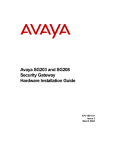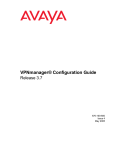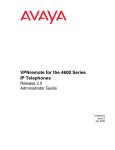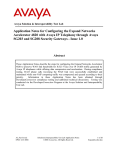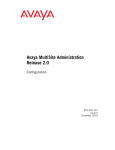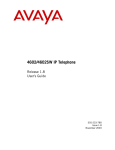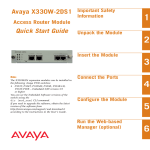Download Avaya SG200 Network Router User Manual
Transcript
Avaya SG5, SG5X, and SG200 Security Gateway Hardware Installation Guide 670-100-102 Issue 2 March 2004 Copyright 2004, Avaya Inc. All Rights Reserved Notice Every effort was made to ensure that the information in this document was complete and accurate at the time of release. However, information is subject to change. Warranty Avaya Inc. provides a limited warranty on this product. Refer to your sales agreement to establish the terms of the limited warranty. In addition, Avaya’s standard warranty language as well as information regarding support for this product, while under warranty, is available through the following website: http://www.avaya.com/support Preventing Toll Fraud “Toll fraud” is the unauthorized use of your telecommunications system by an unauthorized party (for example, a person who is not a corporate employee, agent, subcontractor, or is not working on your company's behalf). Be aware that there may be a risk of toll fraud associated with your system and that, if toll fraud occurs, it can result in substantial additional charges for your telecommunications services. Avaya Fraud Intervention If you suspect that you are being victimized by toll fraud and you need technical assistance or support, in the United States and Canada, call the Technical Service Center's Toll Fraud Intervention Hotline at 1-800-643-2353. Providing Telecommunications Security Telecommunications security (of voice, data, and/or video communications) is the prevention of any type of intrusion to (that is, either unauthorized or malicious access to or use of) your company's telecommunications equipment by some party. Your company's “telecommunications equipment” includes both this Avaya product and any other voice/data/video equipment that could be accessed via this Avaya product (that is, “networked equipment”). An “outside party” is anyone who is not a corporate employee, agent, subcontractor, or is not working on your company's behalf. Whereas, a “malicious party” is anyone (including someone who may be otherwise authorized) who accesses your telecommunications equipment with either malicious or mischievous intent. Such intrusions may be either to/through synchronous (timemultiplexed and/or circuit-based) or asynchronous (character-, message-, or packet-based) equipment or interfaces for reasons of: • Utilization (of capabilities special to the accessed equipment) • Theft (such as, of intellectual property, financial assets, or toll-facility access) • Eavesdropping (privacy invasions to humans) • Mischief (troubling, but apparently innocuous, tampering) • Harm (such as harmful tampering, data loss or alteration, regardless of motive or intent) Disclaimer Avaya is not responsible for any modifications, additions or deletions to the original published version of this documentation unless such modifications, additions or deletions were performed by Avaya. Customer and/or End User agree to indemnify and hold harmless Avaya. Avaya’s agents, servants and employees against all claims, lawsuits, demands and judgements arising out of, or in connection with, subsequent modifications, additions or deletions to this documentation to the extent made by the Customer or End User. How to Get Help For additional support telephone numbers, go to the Avaya Web site: http://www.avaya.com/support/. If you are: • Within the United States, click Escalation Management link. Then click the appropriate link for the type of support you need. • Outside the United States, click Escalation Management link. Then click International Services link that includes telephone numbers for the International Centers of Excellence. Be aware that there may be a risk of unauthorized intrusions associated with your system and/or its networked equipment. Also realize that, if such an intrusion should occur, it could result in a variety of losses to your company (including but not limited to, human/data privacy, intellectual property, material assets, financial resources, labor costs, and/or legal costs). Responsibility for Your Company’s Telecommunications Security The final responsibility for securing both this system and its networked equipment rests with you - Avaya’s customer system administrator, your telecommunications peers, and your managers. Base the fulfillment of your responsibility on acquired knowledge and resources from a variety of sources including but not limited to: • Installation documents • System administration documents • Security documents • Hardware-/software-based security tools • Shared information between you and your peers • Telecommunications security experts To prevent intrusions to your telecommunications equipment, you and your peers should carefully program and configure: • Your Avaya-provided telecommunications systems and their interfaces • Your Avaya-provided software applications, as well as their underlying hardware/software platforms and interfaces • Any other equipment networked to your Avaya products. TCP/IP Facilities Customers may experience differences in product performance, reliability and security depending upon network configurations/design and topologies, even when the product performs as warranted. Standards Compliance Avaya Inc. is not responsible for any radio or television interference caused by unauthorized modifications of this equipment or the substitution or attachment of connecting cables and equipment other than those specified by Avaya Inc. The correction of interference caused by such unauthorized modifications, substitution or attachment will be the responsibility of the user. Pursuant to Part 15 of the Federal Communications Commission (FCC) Rules, the user is cautioned that changes or modifications not expressly approved by Avaya Inc. could void the user’s authority to operate this equipment. Product Safety Standards This product complies with and conforms to the following international Product Safety standards as applicable: • Safety of Information Technology Equipment, IEC 60950, 3rd Edition including all relevant national deviations as listed in Compliance with IEC for Electrical Equipment (IECEE) CB-96A. • Safety of Information Technology Equipment, CAN/CSAC22.2 No. 60950-00 / UL 60950, 3rd Edition • Safety Requirements for Customer Equipment, ACA Technical Standard (TS) 001 - 1997 • One or more of the following Mexican national standards, as applicable: NOM 001 SCFI 1993, NOM SCFI 016 1993, NOM 019 SCFI 1998 Electromagnetic Compatibility (EMC) Standards This product complies with and conforms to the following international EMC standards and all relevant national deviations: Limits and Methods of Measurement of Radio Interference of Information Technology Equipment, CISPR 22:1997 and EN55022:1998. Information Technology Equipment – Immunity Characteristics – Limits and Methods of Measurement, CISPR 24:1997 and EN55024:1998, including: • • • • • • • • • Electrostatic Discharge (ESD) IEC 61000-4-2 Radiated Immunity IEC 61000-4-3 Electrical Fast Transient IEC 61000-4-4 Lightning Effects IEC 61000-4-5 Conducted Immunity IEC 61000-4-6 Mains Frequency Magnetic Field IEC 61000-4-8 Voltage Dips and Variations IEC 61000-4-11 Powerline Harmonics IEC 61000-3-2 Voltage Fluctuations and Flicker IEC 61000-3-3 Federal Communications Commission Statement Part 15: Note: This equipment has been tested and found to comply with the limits for a Class A digital device, pursuant to Part 15 of the FCC Rules. These limits are designed to provide reasonable protection against harmful interference when the equipment is operated in a commercial environment. This equipment generates, uses, and can radiate radio frequency energy and, if not installed and used in accordance with the instruction manual, may cause harmful interference to radio communications. Operation of this equipment in a residential area is likely to cause harmful interference in which case the user will be required to correct the interference at his own expense. Canadian Department of Communications (DOC) Interference Information This Class A digital apparatus complies with Canadian ICES003. Cet appareil numérique de la classe A est conforme à la norme NMB-003 du Canada. This equipment meets the applicable Industry Canada Terminal Equipment Technical Specifications. This is confirmed by the registration number. The abbreviation, IC, before the registration number signifies that registration was performed based on a Declaration of Conformity indicating that Industry Canada technical specifications were met. It does not imply that Industry Canada approved the equipment. DECLARATIONS OF CONFORMITY United States FCC Part 68 Supplier’s Declaration of Conformity (SDoC) Avaya Inc. in the United States of America hereby certifies that the equipment described in this document and bearing a TIA TSB-168 label identification number complies with the FCC’s Rules and Regulations 47 CFR Part 68, and the Administrative Council on Terminal Attachments (ACTA) adopted technical criteria. Avaya further asserts that Avaya handset-equipped terminal equipment described in this document complies with Paragraph 68.316 of the FCC Rules and Regulations defining Hearing Aid Compatibility and is deemed compatible with hearing aids. Copies of SDoCs signed by the Responsible Party in the U. S. can be obtained by contacting your local sales representative and are available on the following Web site: http://www.avaya.com/support All Avaya media servers and media gateways are compliant with FCC Part 68, but many have been registered with the FCC before the SDoC process was available. A list of all Avaya registered products may be found at: http://www.part68.org/ by conducting a search using “Avaya” as manufacturer. China BMSI (Chinese Warning Label) Hardware, including technical data, is subject to U.S. export control laws, including the U.S. Export Administration Act and its associated regulations, and may be subject to export or import regulations in other countries. Customer agrees to comply strictly with all such regulations and acknowledges that it has the responsibility to obtain licenses to export, reexport, or import hardware. Environmental Health and Safety: European Union Declarations of Conformity ! WARNING: Avaya Inc. declares that the equipment specified in this document bearing the “CE” (Conformité Europeénne) mark conforms to the European Union Radio and Telecommunications Terminal Equipment Directive (1999/5/ EC), including the Electromagnetic Compatibility Directive (89/336/EEC) and Low Voltage Directive (73/23/EEC). This equipment has been certified to meet CTR3 Basic Rate Interface (BRI) and CTR4 Primary Rate Interface (PRI) and subsets thereof in CTR12 and CTR13, as applicable. Copies of these Declarations of Conformity (DoCs) can be obtained by contacting your local sales representative and are available on the following Web site: http://www.avaya.com/support Japan This is a Class A product based on the standard of the Voluntary Control Council for Interference by Information Technology Equipment (VCCI). If this equipment is used in a domestic environment, radio disturbance may occur, in which case, the user may be required to take corrective actions. Risk of explosion if battery is replaced by an incorrect type. Dispose of used batteries according to Avaya Environmental Health and Safety guidelines. Documentation: For the most current versions of documentation, go to the Avaya support Web site: http://www.avaya.com/support/ Table of Content About this book 7 Contacting technical support . . . . . . . . . . . . . . . . . . . . . . . . . . . . . . . . . . . . . . . . . 7 Documentation . . . . . . . . . . . . . . . . . . . . . . . . . . . . . . . . . . . . . . . . . . . . . . . . . . . . 8 Chapter 1 Introduction 9 Functional overview . . . . . . . . . . . . . . . . . . . . . . . . . . . . . . . . . . . . . . . . . . . . . . . . 9 Security . . . . . . . . . . . . . . . . . . . . . . . . . . . . . . . . . . . . . . . . . . . . . . . . . . . . . . 10 Plug-and-play installation . . . . . . . . . . . . . . . . . . . . . . . . . . . . . . . . . . . . . . . . 11 Hardware components . . . . . . . . . . . . . . . . . . . . . . . . . . . . . . . . . . . . . . . . . . . . . 12 Available ports . . . . . . . . . . . . . . . . . . . . . . . . . . . . . . . . . . . . . . . . . . . . . . . . . 13 Chapter 2 Installing the security gateway General requirements . . . . . . . . . . . . . . . . . . . . . . . . . . . . . . . . . . . . . . . . . . . . . . Environmental requirements . . . . . . . . . . . . . . . . . . . . . . . . . . . . . . . . . . . . . . Power considerations . . . . . . . . . . . . . . . . . . . . . . . . . . . . . . . . . . . . . . . . . . . . Equipment required . . . . . . . . . . . . . . . . . . . . . . . . . . . . . . . . . . . . . . . . . . . . . System requirements . . . . . . . . . . . . . . . . . . . . . . . . . . . . . . . . . . . . . . . . . . . . Installing the security gateway . . . . . . . . . . . . . . . . . . . . . . . . . . . . . . . . . . . . . . . Chapter 3 Setting up the security gateway for configuration Service provider provisioning . . . . . . . . . . . . . . . . . . . . . . . . . . . . . . . . . . . . . . . Power on self-test . . . . . . . . . . . . . . . . . . . . . . . . . . . . . . . . . . . . . . . . . . . . . . . . . Connecting to the private port of the security gateway . . . . . . . . . . . . . . . . . . . . Performing the quick setup. . . . . . . . . . . . . . . . . . . . . . . . . . . . . . . . . . . . . . . . . . March 2004 15 15 15 16 16 16 17 23 24 24 25 25 5 Avaya SG5, SG5X, & SG200 Security Gateway Hardware Installation Guide Appendix A Specifications Physical specifications. . . . . . . . . . . . . . . . . . . . . . . . . . . . . . . . . . . . . . . . . . . . . . Environmental specifications . . . . . . . . . . . . . . . . . . . . . . . . . . . . . . . . . . . . . . . . Electrical specifications . . . . . . . . . . . . . . . . . . . . . . . . . . . . . . . . . . . . . . . . . . . . . Compliance specifications . . . . . . . . . . . . . . . . . . . . . . . . . . . . . . . . . . . . . . . . . . . Additional features . . . . . . . . . . . . . . . . . . . . . . . . . . . . . . . . . . . . . . . . . . . . . . . . Index 6 29 30 30 31 32 33 March 2004 About this book Avaya SG5, SG5X, and SG200 is the new name for Avaya VSU5, VSU5X, and VSU 500 Security Gateways. Our documentation reflects these new names as of June, 2003. This guide describes the Avaya SG5, the SG5X, and the SG200 Security Gateways and how to install and preconfigure these devices. It is recommended that you read the entire installation guide before installing the security gateway. Contacting technical support Technical support is available to registered users of the Avaya security gateway products. Domestic support • Toll free phone support: (866) 462-8292 (24x7) • Email: [email protected] • Web: http://support.avaya.com International support • For regional support numbers, go to http://www.avayanetwork.com/ site/GSO/default.htm March 2004 About this book 7 Avaya SG5, SG5X, & SG200 Security Gateway Hardware Installation Guide Documentation The security gateway documentation includes both the Hardware Installation Guide and the Security Gateway Configuration Guide for VPNos. You can down load these guides from http://support.avaya.com. Navigate to Product Documentation, VPN and Security. 8 About this book March 2004 Chapter 1 Introduction Functional overview The Avaya SG5, SG5X, and SG200 security gateways are VPN gateways to virtual private networks (VPNs) for small business and home office users. The security gateway allows users to connect securely to their corporate networks and intranets through always-on connections such as DSL and cable modems. Designed to provide the convenience of a firewall and a gateway all in one compact desktop enclosure, the security gateway provides a cost-effective solution to quick and easy VPN deployment while providing strong attack prevention mechanisms against common attacks and Internet security threats. The SG5X and the VSU200 are functionally identical to the SG5, but the VSU5X includes an integrated 7-port Ethernet switch. The VSU200 introduces a cardbus/PCMCIA expansion slot for future functionality, routing capabilities, and firewall enhancements that can be managed from a central-site location. Like other platforms in the Avaya VPN family, the security gateway adds encryption, authentication, and key management to public network data links to ensure privacy and integrity of corporate data, and to enable the efficient and secure operation of VPNs. It is designed to perform complex operations, in real time, without compromising network performance. The security gateway supports a full suite of VPN services including: IPsec-based encryption, packet authentication, and IKE key management, Network Address Translation (NAT), and packet filtering. March 2004 Introduction 9 Avaya SG5, SG5X, & SG200 Security Gateway Hardware Installation Guide Figure 1 SG200 security gateway Security The VSU provides data stream privacy by employing cryptographic algorithms and keys powerful enough for the most sensitive business communications. It supports DES and 3DES encryption, as well as the IKE key management standards. Data authenticity is assured by using MD5™ or SHA-1 hashing algorithms to reject altered or forged packets. All security mechanisms employed by the security gateway conform to IPsec standards, in order to provide interoperability and broaden the use of VPN technology. The security gateway also contains a powerful IP packet filtering engine to provide extensive filtering capabilities, essential when you have a fulltime connection to the Internet. A rule-based method of packet filtering is used, where the priority of the rule is determined by its position in the list (highest is top priority). 10 Introduction March 2004 Avaya SG5, SG5X, & SG200 Security Gateway Hardware Installation Guide Plug-and-play installation The security gateway can be placed anywhere in a 10/100BASE-T LAN to provide VPN functionality. Native support for IP ensures that the security gateway interoperates transparently with the broadest range of intranet and other network applications. Affording fast and easy installation into your new or existing local area network, the security gateway functions as a DHCP server on its private port, supporting VPNs and remote access users. This greatly minimizes the necessary configuration of your workstations and IP devices. The security gateway’s web-based user interface features a quick setup wizard designed to capture essential configuration information for easy initial setup. Provisions are also made to access the web-based interface remotely over the Internet if desired. Where central management of your VPN is required, the optional Avaya VPNmanager network management application (available separately) steps network managers through the setup process and allows them to configure a VPN in minutes. The VPNmanager also supports extensive facilities for VPN monitoring and troubleshooting, and for establishing multi-company extranets. March 2004 Introduction 11 Avaya SG5, SG5X, & SG200 Security Gateway Hardware Installation Guide Hardware components Figure 2 displays the back panel components on each of the security gateways. Figure 2 Back panel components Public Port SG5 Private Port Ethernet Ports Status Indicators Reset Switch Access DC Power Connector Private Ports SG5X Public Port Console Port Private Port Interface Expansion Card/Slot SG200 12 Introduction March 2004 Avaya SG5, SG5X, & SG200 Security Gateway Hardware Installation Guide Available ports The SG5 includes two 10/100BASE-T Ethernet ports that includes a public and private interface port. The SG5X includes one 10/100BASE-T Ethernet port on the public interface, and 7 10/100BASE-T Ethernet ports on the private interface. The SG200 includes two 10/100BASE-T Ethernet ports that includes a public and private interface port, RS-232 console port, and a PC Card Netgear (PCMCIA) expansion port. Table 1 Network zones Media type SG5 SG5X SG200 Ethernet0 Public Public Public Ethernet1 Private Private Private Ethernet2 (Expansion) NA NA • Public backup • Semiprivate • DMZ • Management The status indication of the LEDs on the Ethernet ports are shown in Figure 2. March 2004 Introduction 13 Avaya SG5, SG5X, & SG200 Security Gateway Hardware Installation Guide 14 Introduction March 2004 Chapter 2 Installing the security gateway General requirements This section describes the requirements your site must meet for safe installation and operation of your system. Ensure that you are properly prepared before beginning installation. Environmental requirements The security gateway is intended for use in a normal home office environment. For more extreme conditions, verify that temperature, humidity, and power conditions meet the specifications indicated in Table 2. Table 2 Environmental requirements Item Operating Specification Temperature 32° to 104° F, 0° to 40°C Relative Humidity 5-90%, non-condensing Altitude 0-12,000 feet, 0-3,660 meters Voltage 100-240 VAC Input Frequency 47-63 Hz AC input current 0.4 Amp Additional security gateway specifications are included in Appendix A. March 2004 Installing the security gateway 15 Avaya SG5, SG5X, & SG200 Security Gateway Hardware Installation Guide Power considerations Be sure that the power where the security gateway will be used is “clean” power (free of spikes and noise). Install a power conditioner if necessary. WARNING: This product relies on the building’s installation for shortcircuit (overcurrent) protection. Ensure that a fuse or circuit breaker no larger than 120 VAC, 15A U.S. (240 VAC, 10A international) is used on the phase conductor (all current-carrying conductors). Equipment required The VSU shipping carton should contain: Quantit y Part Description 1 Security Gateway VPN Service Unit 1 DC Power Supply 1 UTP Crossover Cable 1 Power cord (110V) or Power cord (230V) 4 Rubber feet for desktop installations System requirements Before you begin the installation process, confirm the following items are available on your local network: • A router, DSL, cable or ISDN modem, providing connectivity to a WAN such as the Internet • 10/100BASE-T Ethernet hub, router, or switch providing connectivity to a LAN • CAT 3, 4, or 5 UTP cable to interconnect router, VSU, and hub(s) • A Java-enabled (JDK 1.1.8 or later) 128-bit encryption-capable browser such as Internet Explorer 5.5 (or later) or Netscape 6.2 (or later) installed on each workstation on your LAN that will communicate with the security gateway. 16 Installing the security gateway March 2004 Avaya SG5, SG5X, & SG200 Security Gateway Hardware Installation Guide Installing the security gateway Figure 3 shows a typical network using the SG5 security gateway. Figure 3 Typical SG5 installation SG5 March 2004 Installing the security gateway 17 Avaya SG5, SG5X, & SG200 Security Gateway Hardware Installation Guide Figure 4 shows a typical network using the SG5X security gateway. Figure 4 Typical SG5X installation SG5X 18 Installing the security gateway March 2004 Avaya SG5, SG5X, & SG200 Security Gateway Hardware Installation Guide Figure 5 shows a typical network using the SG200 security gateway. Figure 5 Typical SG200 installation SG200 March 2004 Installing the security gateway 19 Avaya SG5, SG5X, & SG200 Security Gateway Hardware Installation Guide Figure 6 Security gateway rear panel connectors Connect Cable between the SG5/5X Private Port and Hub or Workstation Connect Cable between the SG5/5X Public Port and the DSL/Cable Modem Connect Cable between the SG200 Private Port and Hub or Workstation Connect Cable between the SG200 Public Port and the DSL/Cable Modem 20 Installing the security gateway March 2004 Avaya SG5, SG5X, & SG200 Security Gateway Hardware Installation Guide The public port provides an Ethernet interface to the public network (through a DSL or cable modem), while the private port(s) connect to your local network, (typically through a hub in the case of the SG5). All Ethernet ports are 10/100BASE-T compliant host ports. They accept category 3, 4, or 5 UTP cabling terminated in an RJ-45 connector per IEEE 802.3 requirements for 10BASE-T. Perform the following steps to install the security gateway in a typical LAN: 1. Using a standard Ethernet cable, connect the VSU public port to your DSL or cable modem. 2. Connect the private port of the SG5 security gateway to your hub, or in the case of a single user, to your workstation’s Ethernet LAN connector. For the SG5X security gateway, connect the private port to your workstations or IP devices on your LAN. If you’re attaching IP telephones, connect them to the private ports as well. 3. Connect the power cable from the power supply to the VSU, then connect the power supply to an AC outlet. Use the retaining clip provided to secure the power cable to the rear of the security gateway. This prevents the power connector from accidental disconnect. Figure 7 Connecting the DC power supply Retaining Clip 4. March 2004 Proceed to Chapter 3, Setting up the security gateway for configuration. Installing the security gateway 21 Avaya SG5, SG5X, & SG200 Security Gateway Hardware Installation Guide 22 Installing the security gateway March 2004 Chapter 3 Setting up the security gateway for configuration This chapter describes how to set up the security gateway addressing and remote connectivity capabilities in preparation for remote configuration using the VPNmanager software. This preliminary configuration is performed using a browser on your workstation connected to the security gateway’s Private Port. The following procedure assumes that the security gateway has been physically installed on the network, according to the instructions provided in Chapter 2. The security gateway setup consists of two basic steps: • Establishing connectivity between the workstations or IP devices on your local network with the security gateway’s Private Port(s), • Setting up the security gateway’s Public Port to reach the Internet. When the security gateway is initially installed and connected to your local LAN, it is provisioned with a default IP address for the DHCP server (serving the Private Ports) allowing you to access the device through a web browser on your workstation. Through the web interface, you can assign a static IP address for the Public Port, password, etc. Once this has been done, the security gateway can be incorporated into your Virtual Private Network (VPN) by your VPN administrator using remote configuration software from a central location. March 2004 Setting up the security gateway for configuration 23 Avaya SG5, SG5X, & SG200 Security Gateway Hardware Installation Guide Service provider provisioning Your Connection Type Before you begin, you will need to determine if your existing installation uses static IP addresses, dynamic addressing (DHCP), or PPPoE from your service provider. Typically, DSL connections use PPPoE and cable modems use DHCP. Your network administrator can provide you with the information you will need to complete a Quick Setup. You should have this information on hand before you begin the setup procedure. IP telephony considerations For a VoIP connection through a SG5X, a DSL or cable modem connection is required for an acceptable voice quality. As voice traffic is highly sensitive to delay, the quality of the connection depends on the available bandwidth at the time the call is made. The actual available bandwidth may vary significantly depending on the time of day, the number of simultaneous users, and also differs from ISP to ISP. If the SG5X deployment is in a business environment, such as a small office, a Service Level Agreement (SLA) with the service provider can ensure business quality VoIP connections. Up to eight IP telephones can be connected behind the SG5X, depending on network connectivity. Power on self-test After confirming that your connections are correct, apply power to the security gateway. A power-on self test (POST) occurs as soon as power is applied to the security gateway. This test is designed to verify that all security gateway major components are functioning properly. A successfully completed test results in both the VPN and LAN LEDs (on the top of the unit) being off. Boot-up hardware errors are signalled by LED blink codes. Upon a startup failure, both the VPN Traffic LED and the LAN Traffic LED simultaneously blink error codes. Refer to Appendix B for a list of these codes. 24 Setting up the security gateway for configuration March 2004 Avaya SG5, SG5X, & SG200 Security Gateway Hardware Installation Guide Connecting to the private port of the security gateway From the workstation’s control panel, select your TCP/IP network component for your Ethernet controller. In the IP Address window select “enable the setting” to “Obtain an IP address automatically” . Restart your workstation if the operating system asks you to do so. As your workstation restarts, it automatically obtains its required IP address/ mask, and default router IP address from the security gateway. NOTE: Unless you have other DNS servers at your local site, it is recommended that the Windows DNS and WINS server lists be empty. The DNS server built into the security gateway should normally be the sole DNS server that users see. Performing the quick setup Quick Setup collects and preconfigures the essential information required to remotely configure and manage the security gateway. Note: If the security gateway is to be configured and managed locally, see the Security Gateway Configuration Guide for the VPNos, to perform a comprehensive device configuration. The Quick Setup wizard collects the necessary information to communicate with the remote VPNmanager application through the security gateway’s public port. The following information is required to complete the quick setup: • The type of addressing to be used on the security gateway’s public port, either Static IP Addressing, Dynamic Addressing (DHCP), or PPPoE. Typically, DSL connections use PPPoE and cable modems use DHCP. The default is DHCP • A network mask for the above • A default route. This is the service provider’s router used only if Static IP Address is selected • The user name and password, if your connection to your ISP is PPPoE If you are unsure of any of these items, your network administrator should be able to furnish these values to you. March 2004 Setting up the security gateway for configuration 25 Avaya SG5, SG5X, & SG200 Security Gateway Hardware Installation Guide To connect to the security gateway 1. From a workstation on the private side of the security gateway, open your browser and type into the location field one of the following: • https://sg.private • https://192.168.1.1 (security gateway default address) 2. Click Yes to accept the security alert message. The security gateway Login window is displayed. Figure 8 Security gateway login screen 3. Enter the User name root, and the Password enter password. Click Log In. 4. The first time you connect to the security gateway, two sequential popup messages appear over the main screen. The first is a password change alert that advises you to change the factory default password. Change the default password to a secure password. 5. The next alert message indicates that the security gateway has not yet been configured. Click OK to launch the Quick Setup wizard. 6. The Quick Setup wizard dialog is displayed. 26 Setting up the security gateway for configuration March 2004 Avaya SG5, SG5X, & SG200 Security Gateway Hardware Installation Guide Figure 9 Quick setup dialog In the IP Configuration area, select one of the following IP Config Modes. • Static Addressing. If you are going to use static addressing on the public port, click the Static Addressing radio button and enter your IP address, network mask, and default route information. • DHCP. If you plan to use DHCP, the public port automatically obtains its address from a DHCP server. This method is typical for cable modem connections. 7. Depending on the IP config mode selected, complete the fields that populate the dialog. • For Static, enter the IP address, mask and route • For PPPoE, enter the user name and password March 2004 Setting up the security gateway for configuration 27 Avaya SG5, SG5X, & SG200 Security Gateway Hardware Installation Guide 8. In the Centralized Management area, if VPNmanager is used, enter the Super User name superuser and Password enter password. Superuser and password are the default Super User name and Password for Centralized Management. If the Super User and Password are changed, be sure to change the defaults to a secure user name and password and make note of the change as this information is required to send updates from VPNmanager. 9. In the Date & Time area, enter the date, time, and time zone. A 24-hour clock is used. For example, 13:00:00 is equivalent to 1:00 PM. 10. Click Save and then click Log Out from the main page to log of the Web interface. NOTE: When you use Log out, you are prompted to save any unsaved changes before exiting. If you close your browser, unsaved changes are lost. You now have entered enough information to allow the security gateway to be accessed over the Internet. The remaining configuration process can be completed remotely, using VPNmanager, or if the security gateway is managed locally, you can continue the configuration. Refer to the Security Gateway Configuration Guide for VPNos 4.3. 28 Setting up the security gateway for configuration March 2004 Appendix A Specifications This appendix provides physical, environmental and electrical specifications for the security gateway, as well as standards compliance information. Physical specifications Table 3 Physical specifications Parameter SG5 SG5X SG200 Dimensions 6.0" W x 5.0" D x 1.5" H (15.24 x 12.7 x 3.82cm) 7.75" W x 6.5" D x 1.9" H (19.6 x 16.5 x 4.8 cm) 7.75" W x 6.5" D x 2.5" H (19.6 x 16.5 x 6.4 cm) Weight 10 ounces (283.5 grams) 16 ounces (497 grams) 16 ounces (497 grams) LAN Interface One 10/100BASE-T Ethernet port Seven 10/100BASE-T Ethernet ports Two 10/100BASE-T Ethernet ports Management Interfaces One 10/100BASE-T Ethernet port One 10/100BASE-T Ethernet port One 10/100BASE-T Ethernet port, One RS-232 March 2004 Specifications 29 Avaya SG5, SG5X, & SG200 Security Gateway Hardware Installation Guide Environmental specifications Table 4 Environmental specifications Parameter Operating Specification Temperature 32-104°F, 0-40°C Relative Humidity 5-90%, non-condensing Altitude 0-12,000 feet, 0-3,660 meters Electrical specifications Table 5 Electrical specifications Parameter SG5 SG5X SG200 90-264 VAC 90-264 VAC 90-264 VAC Input Frequency 50-60 Hz 50-60 Hz 50-60 Hz AC input current 2.3A max. (100-240VAC) 2.3A max. (100-240VAC) 2.3A max. (100-240VAC) DC Input +5.0 VDC 5%, 6 watts max. +5.0 VDC 5%, 10 watts max. +5.0 VDC 5%, 15 watts max. Internal Battery Memory backup (see Caution below) Memory backup (see Caution below) Memory backup (see Caution below) AC Adapter Voltage CAUTION: Danger of explosion if memory backup battery is incorrectly replaced. Replace only with the same or equivalent type recommended by the manufacturer. Dispose of used batteries according to the manufacturer’s instructions. Note that the battery in this unit is a nonserviceable part. 30 Specifications March 2004 Avaya SG5, SG5X, & SG200 Security Gateway Hardware Installation Guide Compliance specifications Table 6 March 2004 Compliance specifications Parameter Specification Safety Certification CSA, CE, CB SCHEME, EN, C-Tick Mark EMI/RFI FCC Part 15, Class B, EN55022 Class B EN50082-1 VCCI BSMI Standards Compliance IEEE 802.3, Ethernet IPsec Compliance: RFC 2401Security Architecture for the Internet Protocol RFC 2402IP Authentication Header RFC 2403The Use of HMAC-MD5-96 within ESP and AH RFC 2404The Use of HMAC-SHA-1-96 within ESP and AH RFC 2405The ESP DES-CBC Cipher Algorithm with Explicit IV RFC 2406 IP Encapsulating Security Payload RFC 2407Internet IP Security Domain of Interpretation for ISAKMP RFC 2408Internet Security Association and Key Management (ISAKMP) RFC 2409Internet Key Exchange (IKE) RFC 2410The NULL Encryption Algorithm and Its Use with IPsec RFC 2412The OAKLEY Key Determination Protocol RFC 2451The ESP CBC-Mode Cipher Algorithms IPsec ICSA 1.0 Certified (ICSA 1.1 pending) Specifications 31 Avaya SG5, SG5X, & SG200 Security Gateway Hardware Installation Guide Additional features Table 7 32 Specifications Additional features Parameter Specification Encryption DES and 3DES encryption. DES uses a 56-bit key; 3DES uses three 56-bit independent keys for an effective key length of 168 bits. All weak and semi-weak keys are automatically discarded. Authentication Keyed MD5™ Message Digest (RFC 1321) HMAC-MD5 and HMAC SHA-1 (RFC 2104) Key Management IKE (Internet Key Exchange, RFC 2409) Digital Certificates The security gateway uses X.509v3 digital certificates for network management with SSL. Network Address Translation Supports static and port mapping System Management Remote configuration via Java-based VPNmanager™ (configuration traffic secured through SSL) Local configuration via Web-based interface Remote configuration via Web-based interface Secure software download for system upgrades Syslog event and usage logging Software Upgrade Via built-in flash ROM Compatibility Fully compatible with all other VPNware Service Units ICSA-certified IPsec March 2004 Avaya SG5, SG5X, & SG200 Security Gateway Hardware Installation Guide Index A L authentication specification 32 LAN connections log out 28 Login 26 C CE marks 4 compliance specifications 31 configuring static addressing,DHCP,PPPoE connections Ethernet LAN 21 router 21 contacting technical support 7 N network zones table by security gateway 27 Password 26 phone support 7 physical specification 29 plug-and-play installation 11 POST, error codes 24 Power On Self-Test 24 Q 8 Quick Setup E electrical specifications 30 electromagnetic compatibility standards email support 7 encryption specification 32 environmental requirements 15 environmental specification 30 equipment provided by Avaya 16 provided by customer 16 Ethernet ports 13 I IPSec standards 13 P D DES 10 documentation 21 25 R 3 requirements environmental 15 router connections 21 S security 10 security gateway, zones 13 Service Provider Provisioning 24 SHA1 10 SKIP 10 software upgrade specification 32 10 K key management specification March 2004 32 Index 33 Avaya SG5, SG5X, & SG200 Security Gateway Hardware Installation Guide specifications 29 authentication 32 compliance 31 electrical 30 encryption 32 environmental 30 key management 32 physical 29 software upgrades 32 standards electromagnetic compatibility System Requirements 16 3 T technical support triple DES 10 7 W world wide web support 7 Z zones network type of 13 34 Index March 2004


































